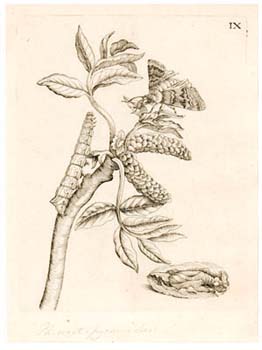Erucarum Ortus Botanical, Moth
- 1717
- Maria Sibylla Merian (German 1647-1717), published posthumously by her daughter
- Engraving, Plate IX, Erucarum Ortus, Alimentum et Paradoxa Metamorphosis
15.2 x 12.0 cm., 6 x 4-11/16" image
- Catherine Carter Goebel, Paul A. Anderson Chair in the Arts Purchase with assistance from a Gift of Mr. and Mrs. George and Pat Olson, Paul A. Anderson Art History Collection, Augustana College 2010.34

Essay by Kristin Douglas, Associate Dean of the College and Professor of Biology
From Antiquity through much of the seventeenth century, it was commonly understood that insects were formed by spontaneous generation in mud, decaying flesh, and other unpleasant substances. It was not until the mid seventeenth century when physicians and naturalists documented insects forming from eggs rather than abiogenesis (Reitsma 68). Even so, observations and descriptions of the complete life cycle from egg to adult, including metamorphosis, had only been completed in a small number of insects. Maria Sibylla Merian (1647-1717), an artist and a naturalist, transformed the early field of entomology through her plates and paintings of butterfly and moth life cycles which were based on her personal observations of live organisms.
Merian was trained in engraving and floral still life painting. Yet, from an early age, she was captivated by insect metamorphosis. At age 13, she began raising silkworms from eggs while carefully describing and painting each stage of the life cycle-egg, larva (caterpillar), pupa within cocoon, and moth. She meticulously documented the metamorphosis of hundreds of moth and butterfly species that she caught in the wild and reared in her home and gardens. Her Study Book (what we would call a lab notebook or field journal today) even contains records of the number of eggs laid by a mated female (Reitsma 24). These detailed data are all the more remarkable when we consider she collected her data with only the aid of a magnifying glass. While other entomologists documented life cycles of insects, Merian's work is distinctive because of the precision and lifelike detail she captured in her plates. Additionally, she included each phase of the life cycle of the species and the host plant on which the caterpillar feeds in each of her paintings.
The detail and accuracy of Merian's work speak to her keen observational skills. These skills were likely honed as she practiced painting still life in her early years. Interestingly, observational skills developed as an artist are the very skills that make Merian such an important figure in science. Taking the time to be curious, pay attention to detail, and capture the detail for others to experience-this is science. Maria Merian was both an artist and a scientist, and her work is adored in both fields.
